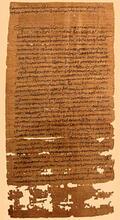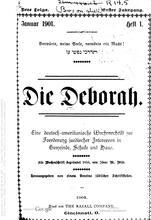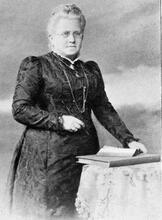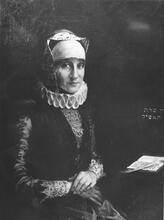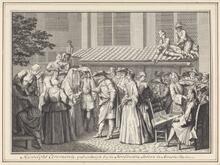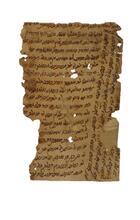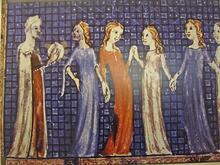Mariamme I The Hasmonean
A Hasmonaean of Judea, Mariamme was likely born in 54 B.C.E. Her family was divided between those in support of the Romans and those against them. Following the death of her father, Mariamme found herself allied with her mother’s pro-Roman house of Hyrcanus. She was betrothed to the future King Herod at twelve years old and married when at seventeen; the pair were married for ten years, after which King Herod executed his wife. The charges brought against Mariamme were vague and thus there are many interpretations as to why she was executed.
Early Life, Alliances, and Marriage
Mariamme was the daughter of Alexander, Aristobulus II’s son, and Alexandra, Hyrcanus II’s daughter. Her grandfathers were the two rival Hasmoneans who invited Rome to intervene in Judaean internal affairs and eventually brought about the downfall of the Hasmonean kingdom. Abraham Schalit calculates that her father and mother could have been married only between 55 and 49 B.C.E., after Alexander’s revolt against Rome was crushed and before his own execution at the hands of the Romans (Ant. 14:125). She was thus probably born in 54 B.C.E.
Her two grandparents displayed opposing political leanings. While Aristobulus fought the Romans to his death, Hyrcanus allied himself with the house of Antipater the Idumean and its Roman patrons. After the death of her father for insurrection against Rome, Mariamme found herself associated with her mother’s house—the pro-Roman house of Hyrcanus. In 42 B.C.E., when she was just twelve, she was betrothed to Herod, heir to Antipater’s house. In 40 B.C.E., her uncle Antigonus (her father’s brother), last surviving scion of the house of Aristobulus, allied himself with Rome’s enemies the Parthians, and invaded Palestine. Herod was put to flight and Mariamme, together with the rest of her family and that of her fiancé, were placed on Masada for safekeeping while Herod hastened to Rome. He returned to Judaea a king, with Rome’s favor and Roman might, retook Judaea and in 37 B.C.E. married Mariamme, who was by then seventeen years old.
Pro-Herodian Interpretations
Herod and Mariamme were married for ten years. She bore him five children during those years—his heirs Alexander and Aristobulus, another son who died and two daughters, Shelamziyyon and Mariamme. In 27 B.C.E. Herod had Mariamme executed. The interpretation of the events that brought about this development is complex. From Josephus it is not clear whether she was executed on a charge of infidelity against the king or on the charge of attempted poisoning. Josephus bases his description on the writing of Nicolaus of Damascus, Herod’s court historian, who decided to make Mariamme a tragic heroine, guilty of no more than the sin of hubris. Others, particularly Herod’s sister Salome who was offended by Mariamme’s pride, took advantage of her gullibility in order to plot against her. When her first attempt to make Mariamme appear guilty of infidelity partly failed (Ant. 15:81–87), she contrived to make her appear to be a poisoner (Ant. 15:222–230), whereupon Herod had her executed. In Nicolaus’ book, Herod is made to look innocent: madly in love with Mariamme, he lost all control of his senses, thus making himself susceptible to belief in rumors spread about his wife by evil wishers.
Hasmoneans Targeted by Herod
This pro-Herodian interpretation must, however, be rejected in light of other evidence, especially the fact that Mariamme’s execution, as Josephus himself notes (Josephus, BJ 1:431–445), cannot be seen separately from the execution or elimination of other Hasmoneans in Herod’s court—Mariamme’s brother Aristobulus III (36 B.C.E.); her grandfather Hyrcanus II (30 B.C.E.); and, after Mariamme’s death, her mother Alexandra (26 B.C.E.) and then her sons Alexander and Aristobulus (7 B.C.E.). Herod never ceased to see in the Hasmoneans his mortal enemies, women as well as men, since in the Hasmonean house a precedent had been created when a woman (SHELAMZIYYON) became queen and ruled independently. Mariamme could see herself—and was probably perceived by others—as a suitable candidate for the monarchy in Judaea. This becomes even more obvious when we learn from Josephus that at least twice, when Herod left his kingdom under embarrassing circumstances, once in 35 B.C.E. and once in 30 B.C.E., Mariamme and her mother tried to win control of the army and other centers of power (Ant. 15:71–73; 205–206). She probably never ceased to see herself as a suitable and legitimate candidate for the throne of Judaea.
Ilan, Tal. Jewish
Women in Greco-Roman Palestine: An Inquiry into Image and Status, p.
68. Tübingen: 1995.
A discussion of Mariamme’s age at marriage
Ilan, Tal. Mine and Yours are Hers: Retrieving Women's History from Rabbinic
Literature. Leiden: 1997, 152–154. Brill, 1998.
A discussion of the single (nameless) portrayal of Mariamme in rabbinic literature,
in comparison with her presentation in Josephus, evaluating (non)historical
value of the former.
Ilan, Tal. Integrating
Jewish Women into Second Temple History. Tübingen: 1999, 105–115.
Presents the thesis that Josephus description of Herod and Mariamme’s romantic
love story is the literary-rhetorical creation of Nicolaus of Damascus.
Ilan, Tal. “King David, King Herod and Nicolaus of Damascus,” Jewish
Studies Quarterly 5 (1998): 195–240.
This paper is a comparison between the portrayal of Herod in Josephus and
of King David in the Bible. Mariamme the Hasmonean and her fate are compared
to Michal daughter of King David and her downfall.
Macurdy, Grace. Vassal-Queens
and Other Contemporary Women in the Roman Empire. Baltimore: 1937,
69–72.
A retelling of Herod and Mariamme’s story strongly influenced by Josephus’
version.
Schalit, Abraham. “The Round Structure at Masada: Mariamme the Hasmonean’s
Tomb?” (Hebrew) Ha-Umma
2 (1963): 356–363.
In this article Schalit suggests that the round structure in (the middle level
in the northern palace) at Masada was actually built by Herod as a mausoleum
to his dead wife Mariamme. He does this by comparing it architecturally to
Augustus’ mausoleum in Rome.
Schalit, Abraham. König
Herodes: Der Mann und sein Werk. Berlin: 1969, 563–644.
In this chapter Schalit tells Herod and Mariamme’s story rather like Josephus,
though he does assign the more dramatic-pathetic representations to the literary
genre employed by Nicolaus of Damascus.

